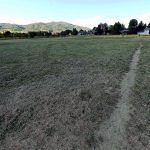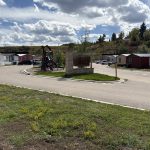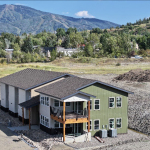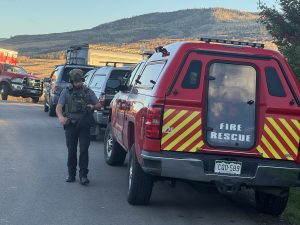Housing authority to local officials: Soils not significant barrier to Brown Ranch development
Memo to government officials from YVHA raises as many questions as answers

Ben Saheb/Courtesy photo
A recent memo to government officials from the Yampa Valley Housing Authority brings forth as many questions as answers regarding the suitability of soil conditions at the proposed Brown Ranch affordable housing development.
The YVHA board of directors submitted a memo last month to the Steamboat Springs City Council and Routt County Commissioners about concerns raised regarding soils at the Brown Ranch development, according to an Oct. 10 email sent to members of the Brown Ranch Deliberation and Stewardship Team.
The memo, initially sent by YVHA Board Vice President Lou Tortora on Sept. 10 — the day after city council formally directed the city’s Deliberation and Stewardship Team, or, DST, to move forward to phase 2 of its process — states that the soils are not a significant barrier to building affordable housing at Brown Ranch.
The memo follows months of community skepticism and scrutiny, from community members both on and off the DST, over a Brown Ranch soils report that revealed potential technical challenges for development.
The soils report had raised alarms with Jim DeFrancia, a consultant with Lowe Enterprises, a firm hired by the housing authority, regarding swelling clay, shallow bedrock and groundwater complications that could increase construction costs and make Brown Ranch less conducive for affordable housing development — without considerable subsidies.
The report, commissioned by the housing authority and completed by Northwest Colorado Consultants Inc. in January 2024, had not previously been shared with the YVHA board or the broader public, a topic addressed by YVHA Executive Director Jason Peasley at council’s May 20 meeting.
“(The memo) is being sent at this time since it appears the issue continues to bubble up on various social platforms,” wrote Tortora. “We appreciate your thoughtful engagement in this process, and I hope the following context and technical clarifications will be helpful as we attempt to move beyond this issue.”
In the memo, Tortora included a summary of activities related to discussion around soils at Brown Ranch, including a DST Inquiry Team meeting earlier this summer.
“The conclusion of the meeting was that the soil at Brown Ranch is similar to the soil in areas in western Routt County and does not necessarily present a significant obstacle in building affordable or other housing,” he wrote.
Tortora then briefly wrote about “expert review” conducted on the soils report by YVHA board members, including himself.
“YVHA board members bring extensive professional expertise to our planning process. In this case, Lou Tortora, PE, and (YVHA Board Member) Patrick Phillips, former global CEO of the Urban Land Institute, have closely reviewed both the NWCC soil report and Mr. DeFrancia’s concerns,” he wrote.
“Their conclusion is clear: the soils at Brown Ranch do not present an unusual or prohibitive development barrier,” he added.
Tortora provided clarifications on issues raised by DeFrancia following a meeting between Tortora, DeFrancia, Phillips and YVHA Deputy Director Elliot Lawrence.
“Jim (DeFrancia) believes that many parties have inferred incorrect conclusions from statements in the email memo that are out of context to the situation at the time,” wrote Tortora, referring to DeFrancia’s email to YVHA leadership in January 2024 that highlighted his concerns.
“His memo does not say that the soils studies in question prevented any development whether for affordable housing or for other uses,” he continued, “and simply calls out concern for the general conditions of soil in the area and the need for additional studies on a site-specific basis.”
The housing authority has undertaken additional studies to nail down the soil conditions, which “should be cited in response to anyone claiming Jim (DeFrancia’s) memo asserts otherwise to development potential,” he added.
One of the aforementioned additional studies is a review of the development of the Sleeping Giant School, where soil-related mitigation added 0-5% to overall construction costs, according to Tortora.
Tortora also noted that at The Cottonwoods at Mid-Valley — a YVHA affordable housing development on the east side of Steamboat Springs with different soil conditions than that of Brown Ranch — mitigation costs were projected at approximately 2% of construction expenses.
“Councilor (Steve) Muntean provided data for a residential property in the area and costs for soil mitigation for a single-family residence were between 2.5% and 5%,” wrote Tortora.
In an interview with the newspaper on Thursday, Muntean clarified that he had spoken to the developer of The Glen (formerly Overlook Park), which contains 130 single-family homes and is near the Brown Ranch site, to understand soil mitigation costs per-home at that development, while acknowledging that it’s “not an apples-to-apples comparison” to Brown Ranch.
“Finally, John Agosta conducted an independent study on soils in the area and found the incremental costs were between 0% and 6%,” Tortora wrote.
Agosta, however, said in an interview with the newspaper on Thursday that he did not conduct an independent study, calling it a “misunderstanding” with Tortora — that instead, he submitted comments to council based on information he heard from a local engineer who wanted to remain anonymous.
The figures provided by the engineer, said Agosta, were related to soil mitigation costs in Hayden.
“I saw the comments that were made, but I don’t really have anything else to add,” said Peasley in an interview with the newspaper on Thursday in regards to the potentially misleading statement in the memo on the “independent study” conducted by Agosta.
Tortora did not respond to requests for comment on Thursday.
“While it is likely portions of Brown Ranch will require more substantial mitigation, the cost of that mitigation will depend on what is being built, where it is being built and how it is being built,” wrote Tortora. “Decisions to move forward on specific portions of the project would be based on detailed design information associated with the nature of the structure being contemplated.”
As the DST moves forward with phase 2, Tortora added: “It is hoped their efforts provide insight into the timing for meeting demand along with the types and number of units that should be considered for Brown Ranch.”
“We are fully committed to transparency and invite council and the commission to weigh all available information — technical reports, projected subsidies and long-term affordability benefits — before drawing conclusions,” Tortora concluded in the memo.

Support Local Journalism

Support Local Journalism
Readers around Steamboat and Routt County make the Steamboat Pilot & Today’s work possible. Your financial contribution supports our efforts to deliver quality, locally relevant journalism.
Now more than ever, your support is critical to help us keep our community informed about the evolving coronavirus pandemic and the impact it is having locally. Every contribution, however large or small, will make a difference.
Each donation will be used exclusively for the development and creation of increased news coverage.










